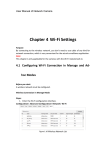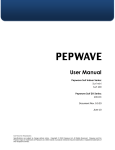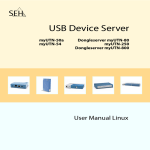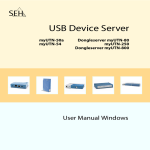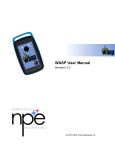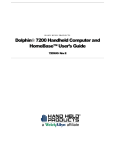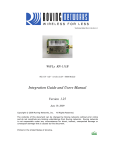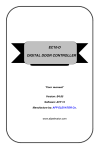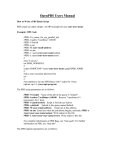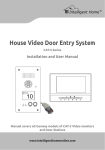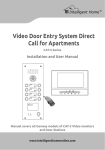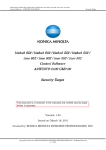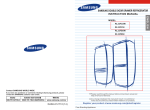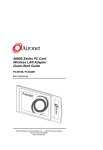Download Preliminary WASP User Manual
Transcript
WASP User Guide Version 1.0.0 (c) 2011 North Pole Engineering, Inc. I WASP User Manual Table of Contents Foreword 0 Part I Introduction 1 Part II Scope 1 Part III What's New 1 Part IV Modes of Operation 1 1 Sleep Mode ................................................................................................................................... 2 2 Startup................................................................................................................................... Mode 2 3 Reset Configuration ................................................................................................................................... Mode 2 4 On Mode ................................................................................................................................... 4 5 Power Down ................................................................................................................................... Mode 4 Part V Quick Start Guide 4 1 Getting................................................................................................................................... Started 4 WASP STARTUP.......................................................................................................................................................... 5 WASP UDP Listening .......................................................................................................................................................... Mode 5 Client Device Query .......................................................................................................................................................... Request 5 WASP Query Response .......................................................................................................................................................... 5 Client Device Connect .......................................................................................................................................................... Request 6 WASP Connect.......................................................................................................................................................... Response 6 Client Device Disconnect .......................................................................................................................................................... Request 6 WASP Disconnect .......................................................................................................................................................... Response 6 2 Default................................................................................................................................... Settings 6 3 Charging ................................................................................................................................... 7 4 Configurable ................................................................................................................................... Hardware Settings 7 5 Network ................................................................................................................................... Operations 7 DHCP Operations .......................................................................................................................................................... 8 Special AdHoc ......................................................................................................................................................... DHCP Server Consideration 8 6 WASP Heartbeat ................................................................................................................................... Process 8 Part VI WASP Hardware 9 1 Overview ................................................................................................................................... 9 2 WiFi-IT! ................................................................................................................................... Module 10 WiFi-IT! Key Features .......................................................................................................................................................... 10 3 ANT Module ................................................................................................................................... 11 Ant AP2 Features .......................................................................................................................................................... 11 ANT+ and ANT+ .......................................................................................................................................................... Alliance 12 4 User Interface ................................................................................................................................... 12 5 Charger ................................................................................................................................... interface 12 (c) 2011 North Pole Engineering, Inc. Contents Part VII WASP Software II 13 1 WiFi-Basic ................................................................................................................................... Language 13 2 WASP................................................................................................................................... WiFi-Basic 14 3 WASP................................................................................................................................... Packet Protocol Summary 14 Part VIII Definitions Index 14 0 (c) 2011 North Pole Engineering, Inc. II 1 1 WASP User Manual Introduction WASP is a standalone unit providing a bridge for ANT+ devices to communicate wirelessly through Wi-Fi networks to other devices or over the Internet. Integrating an NPE WiFi-IT! module, 8channel ANT+ receiver, power management circuitry and rechargeable Li-Ion battery, WASP provides a data gateway for monitoring, recording and analyzing ANT+ data remotely. The water resistant case features an integrated loop for securing the unit to the user while in use. WASP receives data from connected ANT+ devices and translates the data into Wi-Fi packets, making it available to any Wi-Fi connected device. The WASP Application Programmers Interface is an open API that is used by developers to integrate WASP into ANT+ applications. WASP can operate for up to 6 hours on a single charge, or continuously plugged into a computer USB port or wall USB power supply. WASP connects ANT+ devices to a wireless network for monitoring and data collection purposes. For example ANT+ home scales, pulse-oximeter monitors, and blood glucose monitors are all able to use this bridge module to communicate their data to central monitoring stations via the Wi-Fi network. WASP is also usable as a bridge between multiple ANT+ nodes in distributed ANT+ network topologies. Since ANT+ is a personal area network, it has a typical range of approximately two meters. If the ANT+ network is used as a mesh or hub and spoke topology, WASP can join networks together that would normally not be able to communicate with each other because of range limitations. 2 Scope This document provides a general introduction to using the WASP interface. 3 What's New Here are the updates for the latest release and previous releases. Installation 1.4.2 WASP Wifi-Basic 1. First release of the WASP code. 4 Modes of Operation The WASP device has a number of operation modes. Sleep STARTUP WPS Reset Configuration (c) 2011 North Pole Engineering, Inc. Modes of Operation 2 ON Power Down 4.1 Sleep Mode The WASP device starts in SLEEP mode. Power is applied to the device whenever the battery is installed or the USB cable is plugged into a 5V supply. SLEEP mode is a low power mode that cycles every 30 seconds. Every 30 seconds it will wake up and check for two alarms and a GPIO input. The first alarm is attached to the button push. The second alarm is attached to the charge line of the battery charger. The GPIO line detects when power is applied using the USB cable. Any of these three actions will move the device to STARTUP mode. 4.2 Startup Mode The WASP device will enter Startup Mode whenever one of the three startup events occurs. In this mode the power detection circuit is checked. When it is found active then it will automatically enter ON Mode. This always ON Mode sets the green LED to a solid on state. This always on mode will also set the red LED based on the charging state. If the battery is low enough the charger will be active and the red LED will flash the Charging flash rate. Once the battery is fully charged the red LED will be changed to a solid on state. The Charging Flash rate is defined as: ledhicnt (100 ledperiodcnt ledcntsave ledoffcnt ledrepeatsave milliseconds) (100 milliseconds) (count) (100 milliseconds) (count) 10 20 4 0 10 When power is not being applied the change from Startup Mode to On Mode will occur when the button is pushed and held for a minimum of one second. After one second the WASP will start normal On Mode unless the button is held for a total of 5 seconds from the exit of SLEEP mode. If button is released before the 5 seconds then the WASP will remain in normal On mode. If button continues to be held past the 5 seconds the WASP mode will change to WPS mode. The green LED will be in solid on state as soon as the WASP device enters the On Mode. The red LED will be off when on battery only mode. 4.3 Reset Configuration Mode The WASP will enter the Reset Configuration Mode whenever the button is held past 10 seconds from the exit of SLEEP mode. In Reset Configuration Mode the WASP will reset certain configuration variables back to the original values. These variables are listed in the table below: Variable Default Value DHCP 1 IP_ADDRESS 192.168.20.1 (c) 2011 North Pole Engineering, Inc. Definition DHCP active Static IP address when DHCP is 3 WASP User Manual Variable Default Value Definition turned off. Static Subnet when DHCP is turned off. Static IP address when DHCP is turned off. SUBNET 255.255.255.0 GATEWAY 192.168.20.1 Primary SSID Primary Security Primary PASSPHRAS E Primary WEPKEY Primary Channel WASP_AP Primary Wireless AP SSID NONE "0000000000" Primary Security Mode (See table below) Primary WPA Passphrase "0000000000" Primary WEP KEY 6 Primary Channel (options: 1, 6, 11) AdHoc SSID AdHoc Security AdHoc PASSPHRAS E AdHoc WEPKEY AdHoc Channel WASP NONE "0000000000" AdHoc Wireless AP SSID AdHoc Security Mode (See table below) AdHoc WPA Passphrase "0000000000" AdHoc WEP KEY 6 AdHoc Channel (options: 1, 6, 11) WASP NAME <MAC ADDRESS> WASP NAME After the values are returned to their default state, the WASP will set the SLEEP mode and return to main loop. From the main loop the WASP WiFi-Basic code will enter the SLEEP mode. Security Modes Discriptions NONE No Security turn on. WPAPERSONAL WPA Personal (c) 2011 North Pole Engineering, Inc. Modes of Operation 4 Security Modes Discriptions Security Protocol WPA2PERSONAL WPA2 Personal Security Protocol WEPOPEN WEP Open Security Protocol WEPSHARED WEP Shared Security Protocol AUTO Not supported WPAENTERPRISE Not supported WPA2ENTERPRISE Not supported 4.4 On Mode The WASP device will enter On Mode from Startup Mode, WPS Mode, and WPS Fail Mode. In the On Mode the green LED will be set to a solid on state and the red LED will depend on the charging line. In the On Mode the WASP device will run the main network initialization and the main code loop. When in the On Mode the button is pushed and held for a minimum of one second the WASP will enter the Power Down Mode. 4.5 Power Down Mode The WASP device will enter the Power Down Mode when in the On Mode the button is pushed and held for a minimum of one second. In this mode the WASP WiFi-Basic code will set the SLEEP mode and prepare the hardware for sleep. Once the hardware is ready the green and red LED will be in a solid off state and the WASP device will enter sleep. 5 Quick Start Guide Quick Start Guide leads you through beginning to use the WASP and the WASP Packet Protocol. It is simple to use, yet provides all the ANT+, ANT FS and FIT+ functionality you need to work with the ANT+ devices. 5.1 Getting Started The WASP device and WASP WiFi-Basic code does not startup sending data to WIFI radio. It waits for a protocol initialization process to be started by the client device. There are a set of command and responses that make up this protocol initialization process. This process has these steps. 1. WASP STARTUP 2. WASP UDP Listening Mode 3. Client Device Query Request 4. WASP Query Response 5. Client Device Connect Request (c) 2011 North Pole Engineering, Inc. 5 WASP User Manual 6. WASP Connect Response 7. Client Device Disconnect Request 8. WASP Disconnect Response 5.1.1 WASP STARTUP The WASP startup process contains a number of elements related to the hardware. Each WASP device contains a button, one green LED, one red LED, a battery, an ANT chip, a WIFI-IT! chip, a charging circuit, and a USB port for power. The user interface is made up of the button, the two LEDs, and the USB port. See the rest of the WASP User Guide for more information on the WASP hardware and how to use it. In order to power up the device, the user needs to push and hold the button for one second. After one second the green LED would turn on. At this point the WASP device is on and ready to enter step 2. The user could continue to hold the button down for a total 5 seconds from the power up state, then the WASP device would enter the WPS setup mode. In this mode the green LED would flash at a specific rate and pattern to give the user feedback. In the WPS mode, the user would then enable the other WPS device. After this the WPS process is run to exchange the security information. When the WPS process completes successfully it will return to the running state and the green LED would return to a steady on mode. The user could also continue to hold the button down for an additional 5 seconds then the WASP device would enter the reset configuration mode. This is a total of 10 seconds from the power up state. In this mode, certain of the WASP security and configuration information would be reset to the original state. See Reset Configuration Mode. The red LED has a number of functions. When running and not powered through the USB port the red LED is off. When the WASP is plugged into the USB and charging the red LED will be flashing in a specific rate and pattern. Once the WASP is plugged in and fully charged the red LED will return to a solid on mode. There are a number of errors the device could enter. These are explained in the WASP User Guide. The errors will also drive the red LED with different patterns. 5.1.2 WASP UDP Listening Mode The WASP will enter the UDP Listening mode as soon as the button is held for one second after power on. The WASP will either join an existing network or create an AdHoc network. In this mode, the WIFI device next starts a UDP listening on port 17653. The WASP device then starts waiting on WASP protocol command CODE_QUERY_REQ (0x42) to be received. 5.1.3 Client Device Query Request The client device when started up will send the WASP protocol command CODE_QUERY_REQ (0x42) on the current network SSID. The client device will broadcast on the particular subnet of interest. 5.1.4 WASP Query Response Once the WASP WiFi-Basic code sees the CODE_QUERY_REQ (0x42) on the current network SSID it will respond with the CODE_QUERY_RESP (0x43). In this packet the current number of CID spots available would be returned in byte 24 of WASP packet. It also will return the current WASP name string. The default until changed is the WASP device MAC address. (c) 2011 North Pole Engineering, Inc. Quick Start Guide 5.1.5 6 Client Device Connect Request The client device receives the CODE_QUERY_RESP (0x43), checks for available slots, and then determines whether to connect or not. If the device wants to connect it then sends the command CODE_CONNECT_CMD (0x40). 5.1.6 WASP Connect Response The WASP WiFi-Basic code then receives the CODE_CONNECT_CMD (0x40) and returns the CODE_CONNECT_CMD_RESP (0x41). The WASP WiFi-Basic code will also save the CID for this client device and will include it in the current device send list. At this point the WASP device and the client device are connected and ready to do other protocol packets. The client device will need to respond to the HEARTBEAT commands received from the WASP device. The CODE_CONNECT_CMD_RESP (0x41) returns a number of bytes that contain the current setup values. See the WASP Packet Protocol document for the information being returned in this packet. 5.1.7 Client Device Disconnect Request When the client device determines it want to disconnect from this WASP device, it can send the command CODE_DISCONNECT_CMD (0x4C). 5.1.8 WASP Disconnect Response When WASP WiFi-Basic code receives the command CODE_DISCONNECT_CMD (0x4C), it will respond with the command CODE_DISCONNECT_CMD_RESP (0x4D). The code will then remove the specific client device CID from the list of attached devices. 5.2 Default Settings The WASP uses a number of default WIFI settings on initial startup. Project Configuration Settings (PCP) The project configuration settings are loaded when the WASP WiFi-Basic code is loaded. The static IP configuration is used when DHCP is turned off. They are set in the PCP as follows: Static IP: "192.168.20.1" Static Subnet: "255.255.255.0" Static Gateway: "192.168.20.1" Primary Wireless Access Point (WAP) is used when the WASP connects to an Access Point (AP). The PCP settings for the Primary WAP are as follows: Primary SSID: WASP_AP Primary Channel Number: 6. Primary Security Mode: NONE. AdHoc WAP is used when the WASP does not detect and connect to a Primary WAP. The PCP settings for the AdHoc WAP are as follows: AdHoc SSID: "WASP" AdHoc Channel Number: 6 AdHoc Security Mode: NONE. (c) 2011 North Pole Engineering, Inc. 7 WASP User Manual Runtime Settings When the WASP is running the client device and send a SET_CONFIG (0xB4) command that can change the WASP default settings. See the WASP Packet Protocol document for a full description of what can be set by this command. See Network Operations for more description of the network settings. AdHoc DHPC Server Default Settings AdHoc DHCP Server WAP is used when the WASP does not detect and connect to a Primary WAP or a Join AdHoc WAP and DHCP is enabled. The default settings for the AdHoc DHCP Server WAP are as follows: AdHoc SSID: "WASP" AdHoc Security Mode: NONE. AdHoc Channel Number: 6. Server IP: "192.168.21.1" Server Subnet: "255.255.255.0" Server Gateway IP: "192.168.21.1". AdHoc Non-Server Default Settings AdHoc non-server WAP is used when both the Primary WAP and the Join AdHoc WAP fail and DHCP is disabled. The default settiings for the AdHoc non-server WAP are as follows: AdHoc SSID: "WASP" AdHoc Security Mode: NONE. AdHoc Channel Number: 6. Static IP: Current static IP value. Static Subnet: Current static subnet value. Static Gateway: Current static gateway value. 5.3 Charging The WASP provides a mini-USB port to connect to a powered USB port on a computer or a 5V wall transformer. This USB port is connected to an integrated Li-ion battery charger. 5.4 Configurable Hardware Settings There are a number of hardware settings that the WASP depends on. The network settings are described else where in this document. The static IP, the different wireless access points, and DHCP settings all affect how the WASP device connects. There are also some WASP WiFi-Basic settings that can be configured from a client device. The protocol command SET_CONFIG (0xB4) can be used to adjust many of these settings. 5.5 Network Operations The Wasp can either join an existing wireless network or create its own if it cannot join an existing network. Both DHCP and static IP modes are supported as well. When the Wasp powers up, it looks for the network with an SSID value configured as the primary SSID. If the Wasp fails to (c) 2011 North Pole Engineering, Inc. Quick Start Guide 8 join the primary network it then either creates an AdHoc network called WASP, or joins an existing WASP AdHoc network. Primary Wireless Access Point The WASP will join the Primary WAP when the current WASP device settings match that mode. If DHCP is enabled the WASP device will expect to receive the IP configuration from the Access Point (AP). If DHCP is disabled then the WASP device will use the current static IP configuration to access the AP. The WASP device will link using the three channel values of 1, 6, and 11 in order. Join AdHoc Wireless Access Point The WASP will join the AdHoc WAP if WASP device DHCP is active and there is a DHCP server currently running on the AdHoc network. Create AdHoc Non-server Wireless Access Point At this point, if the WASP device fails to join either the Primary WAP or the AdHoc WAP, it will create an AdHoc network. If DHCP is disabled then the WASP device will create an AdHoc network using the current static IP configuration but without a DHCP server running. The default values are listed in Default settings section. Create AdHoc Server Wireless Access Point If DHCP is enabled then the WASP device will create an AdHoc network using the default DHCP server static IP configuration and starts a DHCP server running. The DHCP server will run as any simple DHCP server in a AP mode. The default values are listed in Default settings section. 5.5.1 DHCP Operations If DHCP is enabled the Wasp will attempt to join the primary network and request an IP address from a DHCP server. If the join fails it then will attempt to join the WASP network if it exists and expect to get an address from the Wasp that is running the DHCP server. If it fails to join that network, it then starts its own DHCP server and creates the Wasp network as the DHCP server. 5.5.1.1 Special AdHoc DHCP Server Consideration If the Wasp acting as the DHCP server leaves the network, there is no longer a DHCP server for the network. If another device tries to join this network it will not receive an address. 5.6 WASP Heartbeat Process Once the WASP is powered up and connected to a client device it then starts up a HEARTBEAT process that will wait for 5 minutes looking for activity. Every 5 minutes the WASP WiFi-Basic code will send out a HEART_BEAT_MSG (0x4A). The WASP will then wait for a HEART_BEAT_RESP (0x4B). When the WASP either receives the response or there are other activities either from the client devices or the ANT chip, the WASP code reset the HEARTBEAT. If after 5 minutes the code determines there has been zero activity the HEARTBEAT process moves to HEARTBEAT step 2 and starts sending the HEART_BEAT_MSG (0x4A) every 1 minute. The WASP code will look for a response back within 10 of these commands, if it has not received a response in this amount of (c) 2011 North Pole Engineering, Inc. 9 WASP User Manual time the WASP will enter the sleep mode and the system will need to be setup again. 6 WASP Hardware This section will discuss the WASP Hardware. 6.1 Overview The WASP device has seven main components, the NPE WiFi-IT! module, the 8-channel ANT+ receiver, membrane switch, a green LED, a red LED, USB power connector, regulator, Li-Ion battery charger, and rechargeable Li-Ion battery. The membrane switch is used for multiple functions depending on when and how long you press and hold the switch. See Modes of Operation for more information. Inside Hardware View (c) 2011 North Pole Engineering, Inc. WASP Hardware 10 Membrane Switch and Label 6.2 WiFi-IT! Module The WiFi-IT! wireless module is a low cost, easy to integrate, robust solution for providing Wi-Fi® connectivity for embedded devices. The WiFi-IT! family of modules is perfectly suited for creating a wide variety of wireless applications including sensor-based networks that leverage the existing 802.11 wireless infrastructure. The module combines two ARM7 processors, an RF transceiver, 802.11 MAC, FLASH and SRAM memories with a wide range of interfaces including, two UARTs, two SPI (master and slave), I2C, Digital, Analog and Pulse Width Modulated (PWM) outputs creating a full system on a chip (SoC). The WiFi-IT! module meets FCC/IC regulatory certification and is fully compliant with EU and R&TTE Directive for Radio Spectrum. It is also pre-scan compliant with Japan Radio Type Approval (i.e. TELEC). 6.2.1 WiFi-IT! Key Features FCC/IC/WiFi Certified 802.11 b/g/n Compatible Dual ARM7 Processors for application and networking Small Form Factor (1.28” x 0.9” x 0.143”) Timer and Event Triggered Auto-reporting Capability Analog, Digital, Serial and PWM Interfaces Real-Time Clock with Alarm Inputs and Control Outputs Security: WEP128, WPA-PSK and WPA2-PSK (TKIP / AES) WLAN and TCP/IP Stacks Built-in (c) 2011 North Pole Engineering, Inc. 11 WASP User Manual UART Interfaces Support Hardware Flow Control -40 to +85 °C Operating Temperature Range 3.3 Volt Nominal Operating Voltage 6.3 ANT Module ANT™ is a practical wireless sensor network protocol running on 2.4 GHz ISM band. Designed for ultra low power, ease of use, efficiency and scalability, ANT easily handles peer-to-peer, star, tree and practical mesh topologies. ANT provides reliable data communications, flexible and adaptive network operation and cross-talk immunity. ANT’s protocol stack is extremely compact, requiring minimal micro controller resources and considerably reducing system costs. ANT provides carefree handling of the Physical, Network, and Transport OSI layers. In addition, it incorporates key low-level security features that form the foundation for user -defined, sophisticated, network-security implementations. ANT ensures adequate user control while considerably lightening computational burden in providing a simple yet effective wireless networking solution. ANT supports public, managed and private network architectures with 232 uniquely addressable devices possible, ensuring that each device can be uniquely identified from each other in the same network. ANT is proven with an installed base of over four million nodes in ultra low power sensor network applications in sport, fitness, home and industrial automation. The ANT solutions are available in chips, chip sets and modules to suit a wide variety of application needs. Incorporated in AP2 product family are several ANT core stack enhancements : Background scanning Continuous scanning mode High density node support Improved channel search Channel ID management Improved transmission power control Frequency agility Proximity acquisition The complete description of ANT message protocol is found in the document “ANT Message Protocol and Usage”. This document is available on www.thisisant.com. 6.3.1 Ant AP2 Features 2.4GHz worldwide ISM band 78 selectable RF channels (2403 to 2480MHz) (c) 2011 North Pole Engineering, Inc. WASP Hardware 12 20mm x 20mm drop-in module Ultra low power operation Simple sync/async serial interface Integrated F antenna On board 32.768 kHz crystal oscillator Broadcast, acknowledged, or burst data transmissions ANT channel combined message rate up to 190Hz (8byte data payload) Minimum message rate per ANT channel 0.5Hz Burst transfer rate up to 20Kbps (true data throughput) Up to 8 ANT channels Up to 3 public, managed and/or private network keys 1 Mbps RF data rate, GFSK modulation 1.9V to 3.6V supply voltage range -40°C to +85°C operating temperature Pin compatible with ANT AP1 and AT3 modules Radio regulatory approval for major markets RoHS compliant 6.3.2 ANT+ and ANT+ Alliance ANT+ is the open application layer on the top of the ANT stack. It standardizes communications and facilitates interoperability between a wide array of personal sports, wellness and lifestyle monitoring devices. ANT+ defines device profiles that specify access, data formats, and channel parameters. The ANT+ Alliance is comprised of companies who have adopted the ANT+ promise of interoperability. The Alliance ensures standardized communication through optimized brand value and partnerships with other top tier companies and products. 6.4 User Interface The WASP has a integrated membrane switch which includes a button, a green led, a red led and a graphics overlay. See Modes of Operation for more information. 6.5 Charger interface The WASP provides a mini-USB port to connect to a powered USB port on a computer or a 5V wall transformer. This USB port is connected to an integrated Li-ion battery charger. (c) 2011 North Pole Engineering, Inc. 13 WASP User Manual The red LED is used by the WASP WiFi-Basic code for different charging modes. The Charging Flash rate is defined as: ledhicnt (100 ledperiodcnt ledcntsave ledoffcnt ledrepeatsave milliseconds) (100 milliseconds) (count) (100 milliseconds) (count) 10 20 4 0 10 The Done Charging rate is defined as: ledhicnt (100 milliseconds) 1 ledperiodcnt ledcntsave ledoffcnt ledrepeatsave (100 milliseconds) (count) (100 milliseconds) (count) 0 0 0 255 There are also two charging errors generated by the battery charger. The Charger Bad Battery Error Flash rate is defined as: ledhicnt (100 milliseconds) 10 ledperiodcnt (100 ledcntsave ledoffcnt ledrepeatsave milliseconds) (count) (100 milliseconds) (count) 40 4 60 255 The Charger Tempature Error Flash rate is defined as: ledhicnt (100 milliseconds) 10 7 ledperiodcnt (100 ledcntsave ledoffcnt ledrepeatsave milliseconds) (count) (100 milliseconds) (count) 40 5 60 255 WASP Software This section will discuss the WASP Software. 7.1 WiFi-Basic Language WiFi-Basic is a high-level language developed from the BASIC family of languages with added support for networking and control of hardware interfaces. WiFi-Basic provides a sophisticated and flexible yet easy to use high-level language that supports rapid application development. Using WiFi-Basic together with the WiFi-IT! module eliminates the need for an external processor for most automation and control applications. WiFi Basic provides you with the tools needed to get your WiFi enabled device to market quickly while still being able to maintain and adapt your application for the future. (c) 2011 North Pole Engineering, Inc. WASP Software 7.2 14 WASP WiFi-Basic WASP WiFi-Basic is code developed in the WiFi-Basic Development Environment. It provides the user interface, the ANT packet transmit and receive, the WiFi packet transmit and receive, and all of the WASP Packet Protocol handling. 7.3 WASP Packet Protocol Summary WASP Packet Protocol provides defined packet commands to communicate between the WASP device and a WASP client device running in an application device. It is defined in the WASP Packet Protocol Specification. 8 Definitions WiFi-Basic code is defined as the code running on the WASP that implements this WASP packet protocol. WASP Client Device is defined as the programming interface the WASP Packet Protocol communicates with and would be running in the application device. WASP Protocol Commands are defined as the protocol packets with the specific command code in byte 2 of the packet. There are parts of the packet that are defined common across all the protocol commands. Also, there is specific packet sections defined for each protocol command. WASP API Packet Commands are defined as the packet commands being received by the WiFi-Basic code from the application device. WASP Asynchronous Packet Commands are defined as the packet commands being created by the WiFi-Basic code asynchronously and sent to the application device. WASP Response Packet Commands are defined as the packet commands returned directly by the WiFi-Basic code after receiving one of the WASP API packet commands. Packet Type identifier is defined as bytes 0 and 1 of each WASP Packet and are defined as ASCII characters “A” followed by “N”. Packet Command ID is defined as an incrementing count created by the initiator of the packet, and returned in byte three of the response packet commands. MAC address is defined as the MAC of either the application device or the WASP device depending on who is the sending device. WIFI-IT! firmware is defined as the low level code the WiFi-Basic code runs on top of. ANT Message Protocol is defined in ANT_Message_Protocol_and_Usage_Rev_4.1.pdf document provided by Thisisant.com. Connection ID (CID) as used in WiFi-Basic, is synonymous with socket. (c) 2011 North Pole Engineering, Inc. Back Cover


















